November 24th Scots’ Book of Days – 1331 David Bruce, age 7 years old, crowned King.
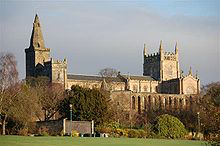 November 24 – 1331 David Bruce, age 7 years old, crowned King. Having been king since age 5, and beginning centuries of minority rulers in Scotland, requiring regents for decades at a time. The raising of royal children by uncles and councils and regents went on for so long, centuries, that the custom exception became the rule of raising the princes or princesses by nannies and tutors. Randolph Earl of Moray was regent and ruled the country. Tytler’s Britannica 57. These customs are still followed today in wealthy areas of New England, such as Greenwich, and Cambridge, or Atlantic Coast in Maclean. Dumfermline Abbey.
November 24 – 1331 David Bruce, age 7 years old, crowned King. Having been king since age 5, and beginning centuries of minority rulers in Scotland, requiring regents for decades at a time. The raising of royal children by uncles and councils and regents went on for so long, centuries, that the custom exception became the rule of raising the princes or princesses by nannies and tutors. Randolph Earl of Moray was regent and ruled the country. Tytler’s Britannica 57. These customs are still followed today in wealthy areas of New England, such as Greenwich, and Cambridge, or Atlantic Coast in Maclean. Dumfermline Abbey.
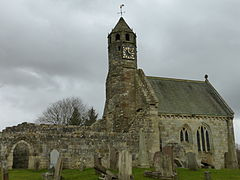 1440 William 6th Earl Douglas, age 15, David Douglas brother, sons of Archibald 5th earl Douglas, and Sir Malcolm Fleming, of Biggar and Cumbernauld, induced to enter capital of Edinbourgh, after magnificent feast, rushed, bound, tried for treason and executed without issue. Anderson Scots v. 2/ p. 44.
1440 William 6th Earl Douglas, age 15, David Douglas brother, sons of Archibald 5th earl Douglas, and Sir Malcolm Fleming, of Biggar and Cumbernauld, induced to enter capital of Edinbourgh, after magnificent feast, rushed, bound, tried for treason and executed without issue. Anderson Scots v. 2/ p. 44.
- Douglas 1036 2Stewart 2Ruthven 2Kinchin 2Jared 2Simmons 2Choate – Douglas 2Montgomberie 2Blair 2Cochrane 2Miller 2Simmons 2Choate – Douglas 2Hamilton 2Stewart 2Miller 2Simmons 2Choate – Douglas 2Carlyle 2Semple 2Montgomery 2Cochrane 2Miller 2Simmons 2Choate
Douglas party executed by the Lord High Treasurer Sir Alexander Livingston when dining with the young King James II (clan Stewart). Later James II returned Fleming lands to his son, Sir Robert, and made him a Lord Fleming of parliament.
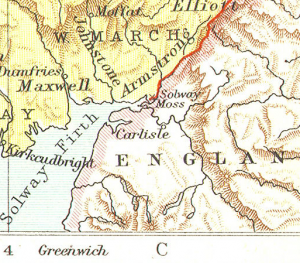 1524 Archibald Douglas 6th Earl Angus, at head of army, possesses capital of Edinburgh, joined by Chancellor Bethune, controls government with possession of young King James 5th Stewart, (age 14). Angus Appoints Angus (himself) Lord Chancellor with great seal. Anderson Scot’s History v. 2/p. 46. Lord Chancellor is equivalent to the chief Justice. The Douglas Earls of Angus were cousins of the Earl Douglas, executed this date 76 years earlier.
1524 Archibald Douglas 6th Earl Angus, at head of army, possesses capital of Edinburgh, joined by Chancellor Bethune, controls government with possession of young King James 5th Stewart, (age 14). Angus Appoints Angus (himself) Lord Chancellor with great seal. Anderson Scot’s History v. 2/p. 46. Lord Chancellor is equivalent to the chief Justice. The Douglas Earls of Angus were cousins of the Earl Douglas, executed this date 76 years earlier.
1542 Rout or Battle of Solway Moss. England. Robert Lord Maxwell and Sir Oliver Sinclair de Patcairns (nobles for Catholic James V King of Scots loss to English Wharton and Musgrove (lieutenants for the Protestant Henry VIII). [TG28-49] .
Cairns. Seat: Mid Calder, West Lothian.
- Cairns Cairnie McGill Ilk 1325 2Chrichton2Maxwell 2Boyd2Douglas 2Ruthven2Kinchin2Jared 2Simmons2Choate zoe TG
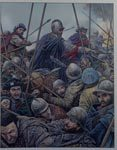 Solway Firth and Solway Moss on the English border amid the Armstrong clan home land in the West March.
Solway Firth and Solway Moss on the English border amid the Armstrong clan home land in the West March.
15 years before, in 1530. John Armstrong,
- Armstrong 17th 2Warren 2Mehew 2Luther 2Choate zoe
known in history as ‘Gilnockie Johnie’, was persuaded by a Royal writ of safe passage to attend a meeting at Caerlanrig with King James 5th who, unknown to Gilnockie, had the malicious intent to silence the rebellious Borderers. The ruse succeeded. Gilnockie and fifty of his followers were captured in direct violation of the safe conduct. A Royal order to hang them was issued, again in violation of James’ own writ of safety, and despite several pleas for the King to be lenient in exchange for obedience, it was carried out. Defiant to the last, Gilnockie said these words directly to King James 5th “I am but a fool to seek grace at a graceless face, but had I known ye would have taken me this day, I would have lived in the Borders despite King Harry and ye both.” His defiance is commemorated and echoed in the soulful popular Border ballad, “Johnie Armstrong”: “Farewell! my bonny Gilnock Hall Where on Esk side thou standest stout ! Gif I had lived but seven yeirs mair I wad a gilt thee round about, John murdered was at Carlinrigg And all his gallant companie; But Scotland’s heart was ne’er sae wae To see sae mony brave men die.”
This murderous act by James V inflamed the Borders region. Far from pacifying, it caused all the Border Clans to question their allegiance to a King who would not honor his own writ of safety. In 1542 at the Battle of Solway Moss, none of the Armstrongs or their allies came to assist James’ forces. The Moss was the playground of the Armstrongs, and they knew every inch of it and used it as a safe retreat for themselves and their families for centuries.
“The Battle of Solway Moss”, Painting by Rick Scollins, circa 1986. Death of James V King of Scotland, 1542
Those of James’ forces who tried to use it so fell into the bogs and were drowned. The rest were cut to ribbons by the English.
The chief Scottish prisoners were taken to Newcastle upon Tyne, and included, pledges and hostages –
James Douglas of Drumlanrig: the Master Customar of Carlisle
- Douglas 1036 2Stewart 2Ruthven 2Kinchin 2Jared 2Simmons 2Choate – Douglas 2Montgomberie 2Blair 2Cochrane 2Miller 2Simmons 2Choate – Douglas 2Hamilton 2Stewart 2Miller 2Simmons 2Choate – Douglas 2Carlyle 2Semple 2Montgomery 2Cochrane 2Miller 2Simmons 2Choate
John Maxwell of Cohill: William Sandes; pledge, Archibald Maxwell, his brother, a child, in Yorkshire.
James Sinclair: Alexander Musgrave: pledge, as for Oliver Sinclair.
John Charteris: William Porter
Robert Charteris: John Wharton
John Maxwell, brother of Lord Maxwell; pledge, his nephew Hugh Maxwell in Yorkshire.
Patrick Hepburn: Lionel Carnaby
Walter Ker, laird of Graddon: Thomas Denton: his pledge with Sir William Gascoigne, senior.
George Hume, laird of Ayton: Thomas Warcup
Laird of Awncastell (John Maitland, laird of ‘Awik Castle’, Annan): Simon Musgrave: pledge, his brother with Thomas Wentworth.
William, Earl of Menteith: Lancelot Lancaster;
Robert Erskine, son of Lord Erskine: Edward Aglionby
Patrick, Lord Gray: Walter Strickland: pledges with the Archbishop of York.
Laurence, Lord Oliphant: Sir John Lowther: pledges with the Bishop of Durham.
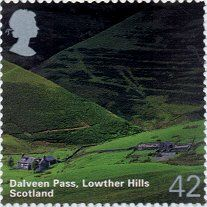 Dalveen Pass, Lowther Hills, Scotland
Dalveen Pass, Lowther Hills, Scotland
www.rampantscotland.com 2003
Oliver Sinclair: Sir John Lowther: pledge, son of the Laird of Cleisburn
Hugh, Lord Somerville: Sir Thomas Curwen
Malcolm, Lord Fleming: Sir William Musgrave: already deceased when the Talbot papers list was compiled.
Gilbert Kennedy, Earl of Cassillis: Sir Thomas Wharton: pledge with Archbishop of Canterbury.
Lord Maxwell; Sir Thomas Wharton; remained at Carlisle in person.
1569 RUTHVEN, WILLIAM, provost of Perth, fourth Lord Ruthven and first Earl of Gowrie, appointed lieutenant of Perth, and bailie and justice of the king’s lands of Scone (Reg. Mag. Sig. Scot. 1546–80, No. 1894);
1572 Earl of Morton (clan Douglas) chosen regent of Scotland for the child James 6th Stewart, Tytler’s Britannica 172.
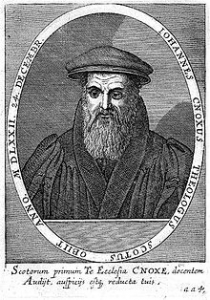 1572 – John Knox dies. In 1564 Knox made a second marriage, which was greatly talked of at the time because the bride was remotely connected with the royal Stewart family. Even more so, the marriage receive much attention because John Knox was 50, while she was a maiden of seventeen! The young lady was Margaret Stewart, daughter of Andrew, Lord Stewart of Ochiltree. She bore Knox three daughters, of whom the youngest, Elizabeth, became the wife of the famous John Welsh, minister of Ayr. http://www.greatsite.com/timeline-english-bible-history/john-knox.html Margaret and John are the ancestors of the Reverend John Witherspoon 18th century, founding father (i.e. signer of the Declaration of Independence), Cora Witherspoon 20th century actor, and Reese Witherspoon 21st century actor.
1572 – John Knox dies. In 1564 Knox made a second marriage, which was greatly talked of at the time because the bride was remotely connected with the royal Stewart family. Even more so, the marriage receive much attention because John Knox was 50, while she was a maiden of seventeen! The young lady was Margaret Stewart, daughter of Andrew, Lord Stewart of Ochiltree. She bore Knox three daughters, of whom the youngest, Elizabeth, became the wife of the famous John Welsh, minister of Ayr. http://www.greatsite.com/timeline-english-bible-history/john-knox.html Margaret and John are the ancestors of the Reverend John Witherspoon 18th century, founding father (i.e. signer of the Declaration of Independence), Cora Witherspoon 20th century actor, and Reese Witherspoon 21st century actor.
John Knox died 24 November 1572 Edinburgh, Kingdom of Scotland
1601 Eglishawe, Eastwood, and Pollock in Renfrewshire, and Crail in Fife are declared infected and shut up. pp. 370 November 24, 1601. A History of Epidemics in Britain from A.D. 664 to the Extinction of Plague Charles Creighton, M.A. M.D. Demonstrator of Anatomy University of Cambridge. 1891
1661 Robert Millar I of Ochiltree. The second minister son of Andrew Millar III of Girvan, Robert, was like his older brother, educated at Glasgow. Wodrow’s Analecta, Vol. III p. 119, cites Robert as one of the best in his class, of whom the Regent said, ‘I never heard argument proposed but thou, Robert Miller, was ever ready to give it an answer.’ Wodrow’s own estimate was of ‘a most eloquent man as ever I heard preach, a great orator, and most plain, but he spoke too fast…. I have often wished he had been one of the Ministers of the New Kirk of Edinburgh; he had such ravishing eloquence and oratory.’
This Robert was admitted, probably as a colleague of the existing minister, between 24 November and 15 December 1661 at St. Conalís Ochiltree. Before the Reformation [1560], the church had belonged to Melrose Abbey, and contained an altar of St. Mary. This was where on Palm Sunday 1564, John Knox married Margaret, daughter of Lord Ochiltree, Robert’s great-great-aunt. 71 YYMA Today [1960], the ruins stand about a block away from the present church, built in 1789 with the cornerstone laid by James Boswell. At the foot of the hill is the site of Lord Ochiltree’s house; slightly downstream on Lugar Water is the auld bridge that carried the ancient highway across the river.
- Boswell of Auchinleck Ayr 13c 2Arnot 2Colville 2Semple 2Montgomerie 2Cochrane 2Miller 2Simmons 2Choate zoe ToaG
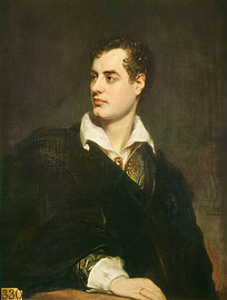 1825 Sir Walter Scott met with Thomas Moore, who was engaged in writing his “Life of Lord Byron”.
1825 Sir Walter Scott met with Thomas Moore, who was engaged in writing his “Life of Lord Byron”.
Portrait of Lord Byron, George Gordon Noel, 6th Baron Byron, FRS (22 January 1788 – 19 April 1824), by Thomas Phillips
Moore published this work in 1830, and dedicated it to Sir Walter Scott by “his affectionate friend, T.M.” Scott records a rather lengthy journal entry for that day, including: ‘On comparing notes with Moore, I was confirmed in one or two points which I had always laid down in considering poor Byron. One was, that like Rousseau he was apt to be very suspicious, and a plain downright steadiness of manner was the true mode to maintain his good opinion. Will Rose told me that once, while sitting with Byron, he fixed insensibly his eyes on his feet, one of which, it must be remembered, was deformed. Looking up suddenly, he saw Byron regarding him with a look of concentrated and deep displeasure, which wore off when he observed no consciousness or embarrassment in the countenance of Rose. Murray afterwards explained this, by telling Rose that Lord Byron was very jealous of having this personal imperfection noticed or attended to.
 Rose Crest: On a chapeau Gules furred Ermine, a harp Azure. Motto CONSTANT AND TRUE.
Badge: wild rosemary Chief: Anna Elizabeth Guillemard Rose of Kilravock
Rose Crest: On a chapeau Gules furred Ermine, a harp Azure. Motto CONSTANT AND TRUE.
Badge: wild rosemary Chief: Anna Elizabeth Guillemard Rose of Kilravock
In another point, Moore confirmed my previous opinion, namely, that Byron loved mischief-making. Moore had written to him cautioning him against the project of establishing the paper called the Liberal, in communion with such men as P.B. Shelley and Hunt, on whom he said the world had set its mark. Byron showed this to the parties. Shelley wrote a modest and rather affecting expostulation to Moore. These two peculiarities of extreme suspicion and love of mischief are both shades of the malady which certainly tinctured some part of the character of this mighty genius; and, without some tendency towards which, genius—I mean that kind which depends on the imaginative power—perhaps cannot exist to great extent. The wheels of a machine, to play rapidly, must not fit with the utmost exactness, else the attrition diminishes the impetus. What I liked about Byron, besides his boundless genius, was his generosity of spirit as well as purse, and his utter contempt of all the affectations of literature, from the school-magisterial style to the lackadaisical. Byron’s example has formed a sort of upper house of poetry. There is 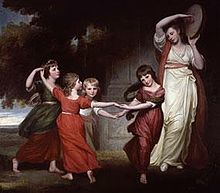 Lord Leveson Gower, a very clever young man. Lord Porchester too, nephew to Mrs. Scott of Harden, a young man who lies on the carpet and looks poetical and dandyish—fine lad too, but—
Lord Leveson Gower, a very clever young man. Lord Porchester too, nephew to Mrs. Scott of Harden, a young man who lies on the carpet and looks poetical and dandyish—fine lad too, but—
“There will be many peers
Ere such another Byron.”
Granville Leveson-Gower´s 1st Marquess of Stafford’s children (1776-7) George Romney, The Marquess’ wife Lady Susanna Stewart was a niece of Cochrane 5th Earl Dundonald, and daughter of Stewart, 6th Earl of Galloway. [The druggist in the 1946 movie It’s a Wonderful Life was Mr. Gower.]
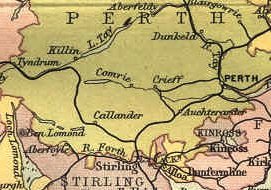 1844 Comrie earthquake. [estimated at 3.0 power], in the southern highlands of Scotland, towards the western end of the Strathearn district of Perth and Kinross, Revelation 8:5 And the angel took the censer, and filled it with fire of the altar, and cast it into the earth: and there was an earthquake.
1844 Comrie earthquake. [estimated at 3.0 power], in the southern highlands of Scotland, towards the western end of the Strathearn district of Perth and Kinross, Revelation 8:5 And the angel took the censer, and filled it with fire of the altar, and cast it into the earth: and there was an earthquake.
Comrie in the middle of the map of Perth.
1864 Benjamin Silliman died. Renowned Yale chemist and scholar, studied in Edinburgh in 1805. In 1854, he became the first person to fractionate petroleum by distillation. A residential college at Yale is named for Siliman, and welcomed Tova Ann Choate (nee Leigh) as a Warren High Scholar for the class of 1996.
1889 November 24 John Lyon died. Born 1803 in Glasgow, Lanarkshire, Scotland. (clan Lyon) John would impact Utah through his poetry and songs. Upon Lyon’s death in 1889, the editor of the Millennial Star thoughtfully recognized the influence of his poem: “Thousands of copies [of his poems compiled in the Harp of Zion] are to be found scattered through the homes of Utah.”68 HISTORY SCOTLAND – MAGAZINE. John’s 3rd great grand-daughter Melodie Lyon Henderson is the choir director in the Arlington 1st Ward, McLean Virginia Stake in 2012. She is an accomplished musical talent. Lyon joined The Church of Jesus Christ of Latter Day Saints in March 1844.
1978 Katherine Marie Heigl born, member of the Church of Jesus Christ of Latter-day Saints, actress, model, film producer. Played character ‘Alison Scott’ in Knocked Up, 2007.
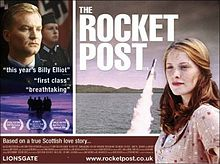 2006 The Rocket Post filmed on Taransay. New Hebridies. In 1934 a German inventor Gerhard Zucker provides a postal service to the island of Scarp by rocket mail.
2006 The Rocket Post filmed on Taransay. New Hebridies. In 1934 a German inventor Gerhard Zucker provides a postal service to the island of Scarp by rocket mail.
Poster.
Disclaimer: The author of each article published on this web site owns his or her own words. The opinions, beliefs and viewpoints expressed by the various authors and forum participants on this site do not necessarily reflect the opinions, beliefs and viewpoints of Utah Standard News or official policies of the USN and may actually reflect positions that USN actively opposes. No claim in public domain or fair use. © John Choate
Utah Standard News depends on the support of readers like you.
Good Journalism requires time, expertise, passion and money. We know you appreciate the coverage here. Please help us to continue as an alternative news website by becoming a subscriber or making a donation. To learn more about our subscription options or make a donation, click here.
To Advertise on UtahStandardNews.com, please contact us at: ed@utahstandardnews.com.


Comments - No Responses to “November 24th Scots’ Book of Days – 1331 David Bruce, age 7 years old, crowned King.”
Sure is empty down here...